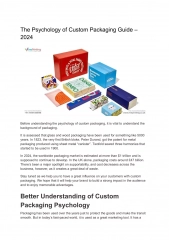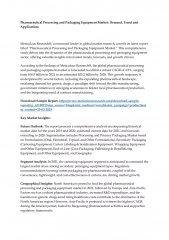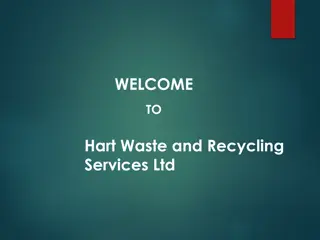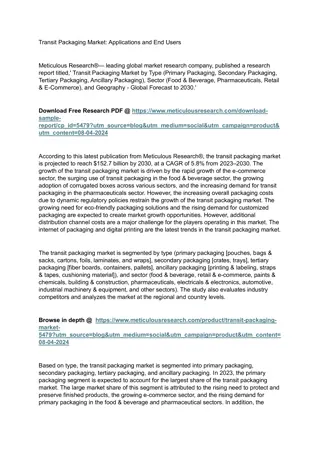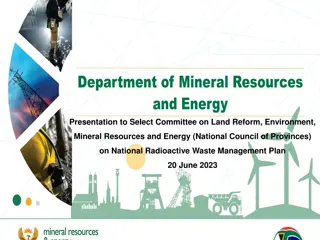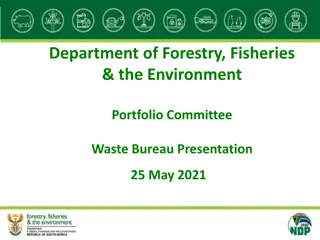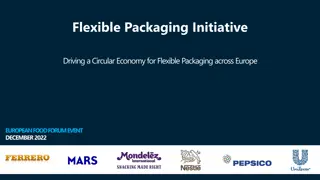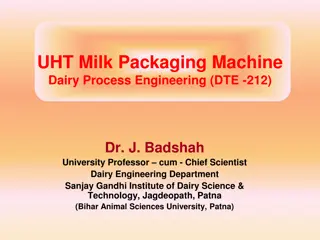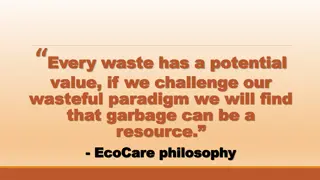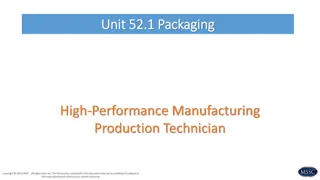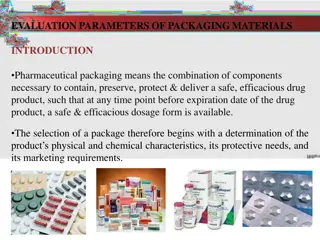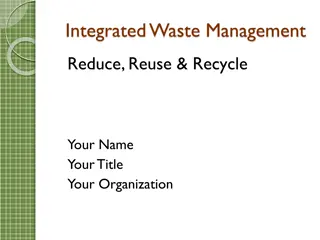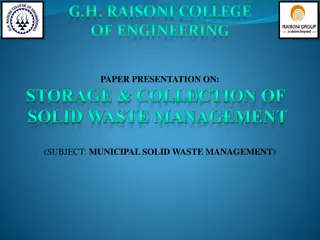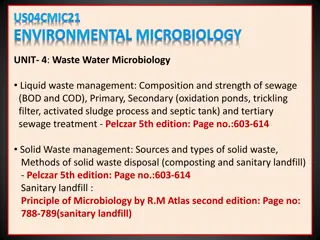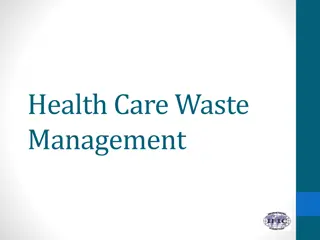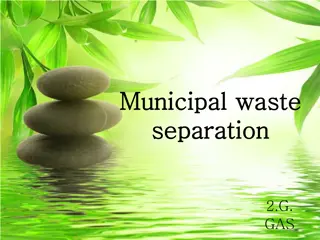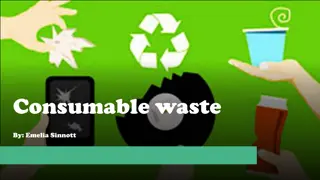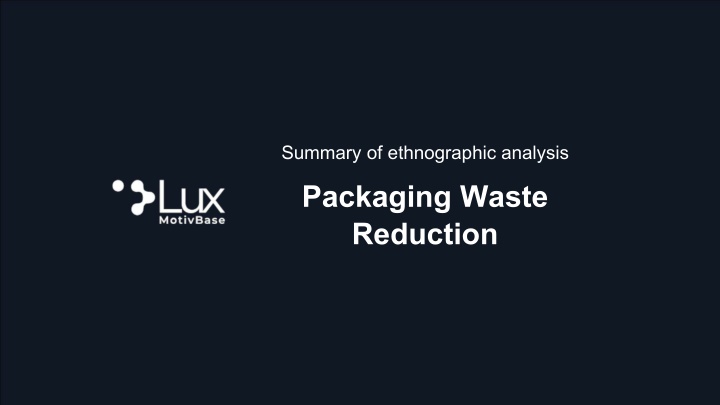
Analyzing Packaging Waste Reduction Culture Through Ethnographic Study
"Explore the impact of packaging waste reduction culture through ethnographic analysis and consumer motivations. Discover the core beliefs and manifestations driving consumer actions towards sustainability. Uncover the demographic insights and social classes involved in this movement."
Download Presentation

Please find below an Image/Link to download the presentation.
The content on the website is provided AS IS for your information and personal use only. It may not be sold, licensed, or shared on other websites without obtaining consent from the author. If you encounter any issues during the download, it is possible that the publisher has removed the file from their server.
You are allowed to download the files provided on this website for personal or commercial use, subject to the condition that they are used lawfully. All files are the property of their respective owners.
The content on the website is provided AS IS for your information and personal use only. It may not be sold, licensed, or shared on other websites without obtaining consent from the author.
E N D
Presentation Transcript
Summary of ethnographic analysis Packaging Waste Reduction
SOCIAL MEDIA ANALYTICS Direct conversations about a topic SOCIAL MEDIA ANALYTICS Direct conversations about a topic METHODOLOGY Using machine intelligence + PhD Anthropologists, we conduct an observational study of consumer language to decode beliefs. SCALE Our engine scrapes data from (and studies) more than 20M consumers between the ages of 18-74 each monthNOTE: For global analysis, check our support portal for any limitations in data and representation. 2 ANTHROPOLOGY Direct and Indirect contextual conversations about a topic BY ANALYZING THE ASSOCIATIONS OF THE ASSOCIATIONS WE DISCOVER THE FORCES OF CHANGE REPRESENTATION It's 2024! We have no problem finding a representative sample of consumers between the ages of 18-74 in the western world. However, nothing is perfect. We do allow for approx 4% margin of error in demographic reporting.
Packaging Waste Reduction How relevant is this space? Relevant to 32.2M people and growing by 27.3% over the next 12-24 months. 3 This culture has not reached its tipping point yet. This means consumers have only recently developed a clear sense of what they want in this space but there is still room for change.
Who is the consumer behind this culture? Motivations & Demographics Motivation They want to prove that they are playing their part (in making the world a better place). This group is driven to make a difference through their actions. They support multiple causes through a variety of ways including donations, volunteering, awareness raising etc., for it allows them to put themselves through hardship (even in a smaller or temporary way) for a worthwhile cause. In their minds, this is more powerful than just words and helps to make the world slightly better than how they found it. 70% of the audience falls into the following Family Type categories: single, couples without children 37% of the audience falls into the following Age Bracket categories: 18-20, 21-24, 35-44 68% of the audience falls into the following Social Class categories: middle class, upper middle class 4
Set up: Iceberg model of meaning This is our context. It's the part of the iceberg that s visible to us all. Consumers in your marketplace will have no trouble talking about this macroculture when asked questions about it. But their responses will tend to be logical and framed. MACROCULTURE implicit meaning line This is the most dangerous or valuable part of the culture where core beliefs are held. These core beliefs are hidden from plain sight and drive the consumer's decisions. People will often have a very difficult time articulating these beliefs and that is where observational research is key. CORE BELIEFS This is the least dangerous part of the culture. That is, these manifestations are current ways in which the consumer's beliefs manifest out in the market. This is also the part of the culture that changes the most because manifestations are behaviors that change and evolve quite often as new technologies and solutions are launched. CURRENT MANIFESTATIONS
These are the core beliefs that define the consumer in the context of Packaging Waste Reduction 1. Supporting Innovative Brands Packaging Waste Reduction = Buying from brands that are leading the way when it comes to reduced packaging. 3. Boosting a Sustainable Economy Packaging Waste Reduction = Saving money, and promoting a sustainable circular economy. 6 NEW IDEAS EARLY CONSENSUS 2. Navigating Increased Complexity Packaging Waste Reduction = Balancing unexpected challenges and consequences rooted in the complexity of packaging waste reduction. 4. Adopting Alternatives to Plastic Packaging Waste Reduction = Going plastic-free for the benefit of the environment.
1. Supporting Innovative Brands Core Belief Core Belief Packaging Waste Reduction = Buying from brands that are leading the way when it comes to reduced packaging. Current manifestations of this belief These consumers believe that increasing the number of stores that offer bulk purchasing options will help decrease packaging usage and reduce overall waste. They discuss leveraging the power of their wallet to support businesses that make it easier to recycle hard-to-recycle packaging. They're excited to buy from brands that are working to reduce the amount of packaging waste that is already present in our ecosystem. 7 Consumers want to support the future expansion of local products, thinking local means less packaging waste.
2. Navigating Increased Complexity Core Belief Core Belief Packaging Waste Reduction = Balancing unexpected challenges and consequences rooted in the complexity of packaging waste reduction. Current manifestations of this belief Consumers worry that folks on a low-income may struggle with the increased costs rooted in packaging waste reduction initiatives. Some worry that the implementation of eco-friendly measures like banning single-use plastics, may reveal other sustainability problems with alternative materials. Consumers worry that unfamiliarity with proper disposal of new packaging forms could discourage participation in waste reduction efforts. 8 These consumers wonder if transitioning to minimal packaging will lead to logistical transportation challenges and additional waste.
3. Boosting a Sustainable Economy Core Belief Core Belief Packaging Waste Reduction = Saving money, and promoting a sustainable circular economy. Current manifestations of this belief Consumers want to reduce their package waste and save money in the long run by using refillable containers that will last for years. They hope that packaging waste reductions will lead to more job opportunities to design, manufacture, sell, and recycle the sustainable packages of tomorrow. These consumers feel that both individuals and corporations should be able to reap financial benefits for doing their part to reduce packaging waste. 9 While they expect products with reduced packaging to come at a lower cost, they're disappointed when companies charge more for them.
4. Adopting Alternatives to Plastic Core Belief Core Belief Packaging Waste Reduction = Going plastic-free for the benefit of the environment. Current manifestations of this belief They think recycling plastic is unsustainable in the long term, because most plastics lose value after being recycled a few times, so they're looking for packaging materials that have a long recyclability lifespan. Consumers seek products that prioritize organic packaging materials as an easily disposable alternative to plastic packaging. Consumers think that some plastic alternatives can be even more efficient and versatile than to single-use plastic packaging. 10 Some consumers look to the past to rethink how they can avoid using plastics using traditional methods of packaging products from around the world.
Your action plan It's time for some homework Mid term opportunities Short term opportunities Packaging Waste Reduction = Buying from brands that are leading the way when it comes to reduced packaging. Packaging Waste Reduction = Balancing unexpected challenges and consequences rooted in the complexity of packaging waste reduction. Packaging Waste Reduction = Saving money, and promoting a sustainable circular economy. Packaging Waste Reduction = Going plastic-free for the benefit of the environment. Core beliefs DNA Current manifestations of core belief Product DNA (In what ways is your product delivering against these beliefs?) - - - - Brand DNA (In what ways is your brand delivering against these beliefs?) - - - - Future manifestations of core belief Product DNA (In what ways could your product deliver against these beliefs?) - - - - Brand DNA (In what ways could your brand deliver against these beliefs?) - - - -

